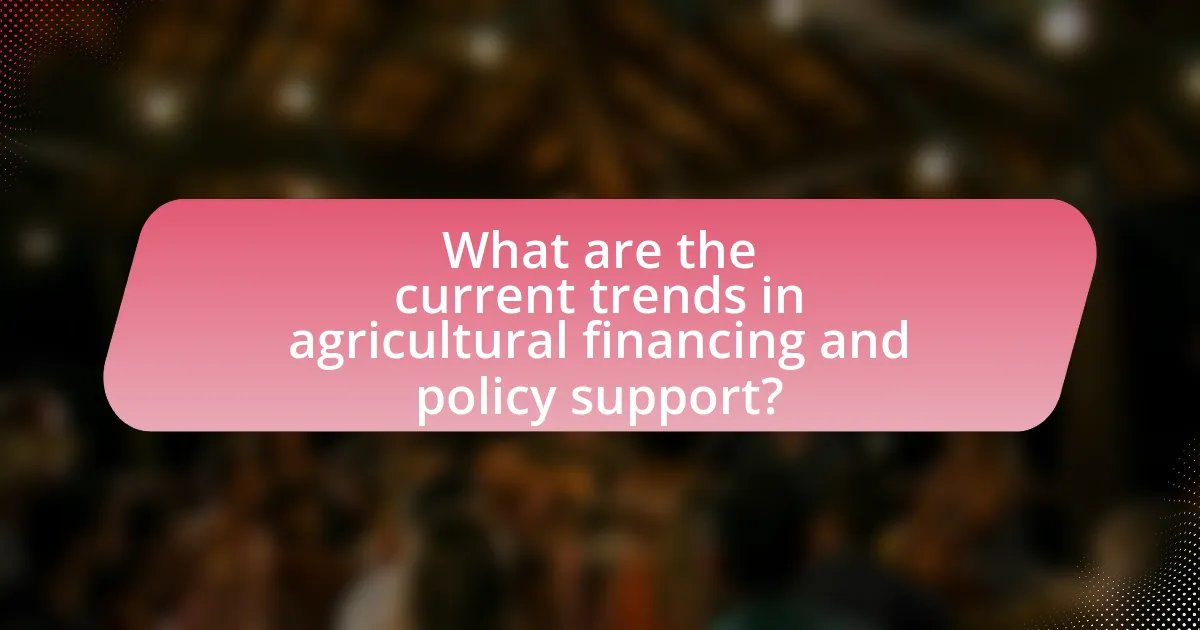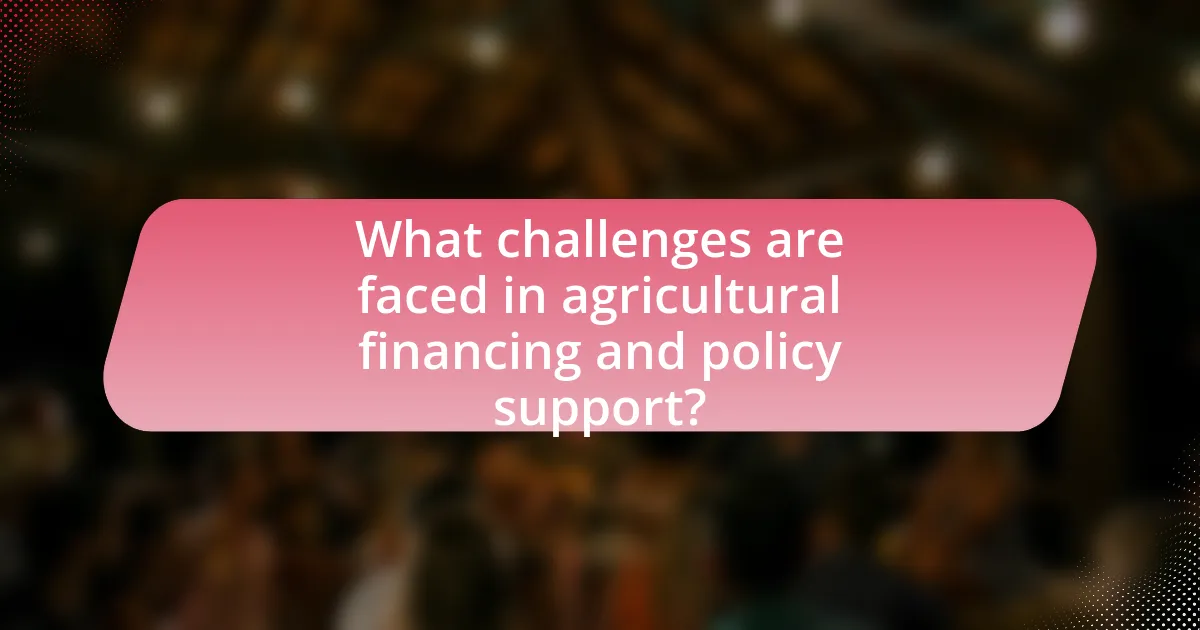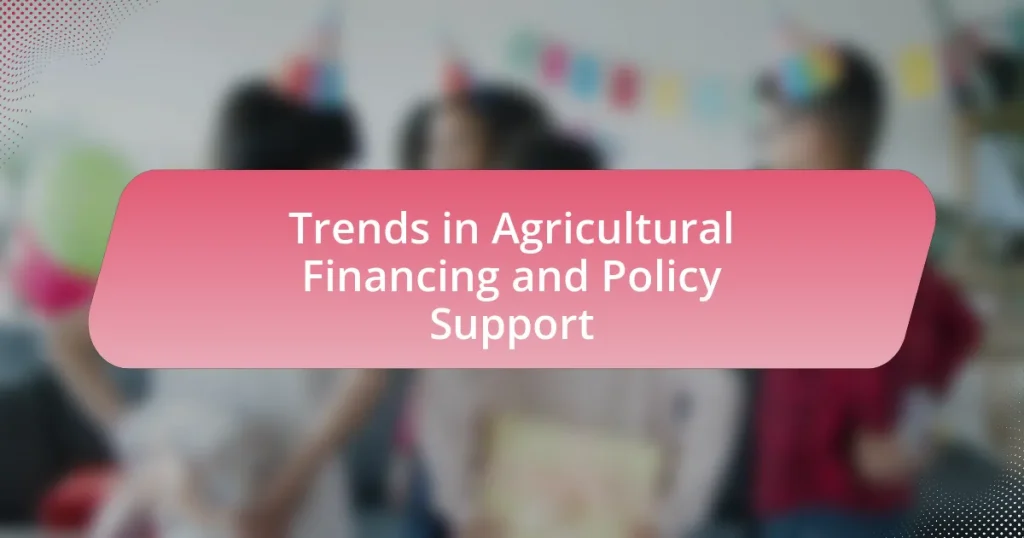The article focuses on current trends in agricultural financing and policy support, highlighting the increased access to digital financial services, sustainability initiatives, and government support for smallholder farmers. It examines how recent economic changes, such as rising interest rates and fluctuating commodity prices, impact farmers’ access to financing and the role of government policies in shaping the agricultural financing landscape. Additionally, the article discusses emerging innovations in financing, the challenges faced by farmers, and the implications of climate change on agricultural financing policies. It concludes with insights on future directions, best practices, and strategies for improving access to financing in the agricultural sector.

What are the current trends in agricultural financing and policy support?
Current trends in agricultural financing and policy support include increased access to digital financial services, a focus on sustainability, and enhanced government support for smallholder farmers. Digital financial services, such as mobile banking and fintech solutions, have expanded access to credit and insurance for farmers, enabling them to invest in technology and improve productivity. Sustainability initiatives are gaining traction, with policies promoting environmentally friendly practices and investments in climate-resilient agriculture. Additionally, governments are implementing targeted support programs, such as subsidies and grants, aimed at empowering smallholder farmers, which constitute a significant portion of agricultural production in many countries. For instance, the Food and Agriculture Organization reported that smallholder farmers produce up to 80% of the food supply in developing nations, highlighting the importance of these support mechanisms.
How have recent economic changes influenced agricultural financing?
Recent economic changes have significantly influenced agricultural financing by increasing interest rates and altering commodity prices. Higher interest rates, driven by central banks’ efforts to combat inflation, have raised borrowing costs for farmers, making it more challenging to secure loans for operational expenses and capital investments. Additionally, fluctuations in commodity prices, influenced by global supply chain disruptions and changing consumer demand, have affected farmers’ revenue projections, leading to more cautious lending practices from financial institutions. For instance, the U.S. Department of Agriculture reported that in 2022, the average interest rate for farm loans rose to 5.5%, up from 4.5% in 2021, reflecting the tightening credit environment. These economic factors have prompted a shift towards more conservative financial strategies within the agricultural sector, impacting overall investment and growth potential.
What specific economic factors are driving changes in agricultural financing?
Rising interest rates are a specific economic factor driving changes in agricultural financing. As central banks increase rates to combat inflation, the cost of borrowing for farmers and agricultural businesses rises, leading to a reevaluation of financing strategies. Additionally, fluctuations in commodity prices impact farmers’ income stability, influencing their ability to secure loans. For instance, the volatility in prices for crops like corn and soybeans can affect cash flow projections, making lenders more cautious. Furthermore, shifts in government policies, such as subsidies and trade agreements, also play a critical role in shaping the agricultural financing landscape, as they can either enhance or restrict access to capital.
How do these economic changes affect farmers’ access to financing?
Economic changes, such as fluctuations in commodity prices and shifts in interest rates, significantly affect farmers’ access to financing. When commodity prices decline, farmers often experience reduced income, leading to increased difficulty in securing loans as lenders perceive higher risk. For instance, a study by the Food and Agriculture Organization indicates that during periods of low prices, loan default rates among farmers rise, prompting banks to tighten lending criteria. Additionally, rising interest rates can elevate borrowing costs, further constraining farmers’ ability to finance operations and investments. Consequently, these economic changes create a challenging environment for farmers seeking financial support.
What role do government policies play in agricultural financing?
Government policies play a crucial role in agricultural financing by providing financial support, risk management tools, and regulatory frameworks that facilitate access to credit for farmers. These policies often include subsidies, grants, and low-interest loans aimed at enhancing agricultural productivity and sustainability. For instance, the U.S. Department of Agriculture (USDA) offers various loan programs that help farmers secure funding for operational costs and investments in technology. Additionally, government-backed insurance programs mitigate risks associated with crop failures, thereby encouraging lenders to finance agricultural ventures. Such policies are essential for stabilizing the agricultural sector and promoting food security, as evidenced by the significant increase in farm income attributed to government interventions during economic downturns.
Which government policies are currently impacting agricultural financing?
Current government policies impacting agricultural financing include interest rate subsidies, loan guarantee programs, and direct financial assistance initiatives. Interest rate subsidies lower borrowing costs for farmers, making it easier for them to access credit. Loan guarantee programs, such as those offered by the USDA, reduce lender risk, encouraging banks to provide loans to agricultural producers. Additionally, direct financial assistance initiatives, like disaster relief funds, provide immediate support to farmers affected by adverse conditions, ensuring their financial stability. These policies collectively enhance access to capital for agricultural operations, promoting growth and sustainability in the sector.
How do these policies support or hinder agricultural development?
Agricultural policies can either support or hinder agricultural development depending on their design and implementation. Supportive policies, such as subsidies for inputs like seeds and fertilizers, enhance productivity and encourage investment in technology, leading to increased crop yields. For instance, the U.S. Farm Bill provides financial assistance to farmers, which has historically resulted in higher agricultural output and improved food security. Conversely, restrictive policies, such as excessive regulation or lack of access to credit, can stifle innovation and limit farmers’ ability to expand operations. For example, stringent land-use regulations can prevent farmers from optimizing their land for production, ultimately hindering growth in the agricultural sector.
What innovations are emerging in agricultural financing?
Innovations emerging in agricultural financing include the use of blockchain technology, digital platforms for crowdfunding, and precision agriculture financing models. Blockchain technology enhances transparency and traceability in transactions, reducing fraud and improving trust among stakeholders. Digital crowdfunding platforms allow farmers to access capital directly from investors, bypassing traditional financial institutions, which can be slow and risk-averse. Precision agriculture financing models leverage data analytics to provide tailored financial products based on specific farm needs and performance metrics, optimizing resource allocation and increasing productivity. These innovations are reshaping the agricultural financing landscape, making it more accessible and efficient for farmers.
How are technology and digital platforms transforming agricultural financing?
Technology and digital platforms are transforming agricultural financing by enhancing access to capital, improving risk assessment, and streamlining transactions. Digital platforms enable farmers to connect directly with lenders, reducing reliance on traditional banking systems, which often have stringent requirements. For instance, platforms like Kiva and AgriDigital facilitate peer-to-peer lending and provide farmers with microloans, allowing them to secure funding more easily. Additionally, the use of data analytics and mobile applications helps lenders assess creditworthiness based on real-time agricultural data, such as crop yields and market prices, rather than solely on historical financial records. This shift not only democratizes access to financing but also increases the efficiency of fund allocation in the agricultural sector.
What are the benefits of innovative financing models for farmers?
Innovative financing models provide farmers with increased access to capital, enabling them to invest in technology, improve productivity, and enhance sustainability. These models, such as crowdfunding, peer-to-peer lending, and impact investing, often offer more flexible terms compared to traditional bank loans, allowing farmers to tailor financing to their specific needs. For instance, a study by the Food and Agriculture Organization (FAO) highlights that innovative financing can reduce the cost of capital by up to 30%, making it more feasible for farmers to adopt modern agricultural practices. Additionally, these models can foster collaboration among farmers, investors, and agricultural organizations, creating a supportive ecosystem that drives growth and innovation in the agricultural sector.
How do international trends affect local agricultural financing?
International trends significantly influence local agricultural financing by shaping investment flows, policy frameworks, and market access. For instance, global demand for sustainable agricultural practices has led to increased funding for eco-friendly farming initiatives, as seen in the rise of green bonds and impact investing, which totaled over $500 billion in 2020. Additionally, international trade agreements can alter local financing conditions by either facilitating access to foreign capital or imposing restrictions that limit funding sources. The World Bank’s reports indicate that countries aligning their agricultural policies with international standards often attract more foreign direct investment, enhancing local financing opportunities. Thus, the interplay between global trends and local agricultural financing is evident through shifts in investment patterns and policy adaptations.
What are the implications of climate change on agricultural financing policies?
Climate change significantly impacts agricultural financing policies by increasing the risk associated with agricultural investments. As climate variability leads to unpredictable weather patterns, crop yields become less reliable, prompting financial institutions to reassess lending criteria and risk assessments. For instance, the World Bank reports that climate change could reduce agricultural productivity by up to 25% in some regions by 2050, which directly influences the willingness of banks to finance agricultural projects. Consequently, agricultural financing policies may shift towards supporting climate-resilient practices and technologies, such as sustainable farming methods and crop diversification, to mitigate these risks. This adaptation in policy is essential to ensure food security and economic stability in the face of climate challenges.

What challenges are faced in agricultural financing and policy support?
Agricultural financing and policy support face several significant challenges, including limited access to credit, inadequate infrastructure, and fluctuating market conditions. Limited access to credit is a primary barrier, as many farmers, especially smallholders, struggle to secure loans due to high collateral requirements and perceived risks by financial institutions. Inadequate infrastructure, such as poor transportation and storage facilities, further complicates the ability of farmers to access markets and financing. Additionally, fluctuating market conditions, driven by factors like climate change and global commodity prices, create uncertainty that discourages investment in agriculture. These challenges hinder the overall growth and sustainability of the agricultural sector, impacting food security and economic development.
What barriers do farmers encounter in accessing financing?
Farmers encounter several barriers in accessing financing, including lack of collateral, limited financial literacy, and high interest rates. These obstacles hinder their ability to secure loans necessary for operational and capital investments. For instance, many farmers do not possess sufficient assets to meet collateral requirements set by lenders, which restricts their borrowing capacity. Additionally, a study by the Food and Agriculture Organization (FAO) highlights that inadequate financial literacy among farmers leads to poor understanding of financing options and repayment terms, further complicating their access to funds. High interest rates imposed by financial institutions also deter farmers from seeking loans, as they may perceive the cost of borrowing as too burdensome.
How do credit risks impact farmers’ ability to secure loans?
Credit risks significantly hinder farmers’ ability to secure loans by increasing the perceived likelihood of default among lenders. When farmers face high credit risks, such as poor credit history or unstable income due to factors like weather variability, lenders become more cautious and may impose stricter lending criteria or higher interest rates. According to a study by the Food and Agriculture Organization, approximately 40% of smallholder farmers in developing countries are unable to access credit due to these perceived risks, which limits their capacity to invest in essential resources like seeds and equipment. This creates a cycle where limited access to financing further exacerbates their financial instability, making it even more challenging to secure loans in the future.
What role does financial literacy play in farmers’ financing challenges?
Financial literacy significantly impacts farmers’ financing challenges by equipping them with the knowledge to make informed financial decisions. Farmers with higher financial literacy are better able to understand credit options, manage cash flow, and assess investment risks, which directly influences their ability to secure funding. Research indicates that a lack of financial literacy can lead to poor financial management, resulting in increased debt and reduced access to credit. For instance, a study by the Food and Agriculture Organization found that farmers with low financial literacy are 30% less likely to apply for loans compared to their more financially literate counterparts. This demonstrates that enhancing financial literacy can improve farmers’ financial stability and access to necessary resources.
How do policy inconsistencies affect agricultural financing?
Policy inconsistencies negatively impact agricultural financing by creating uncertainty for investors and lenders. When government policies regarding subsidies, tariffs, or regulations fluctuate, financial institutions become hesitant to provide loans or investment, fearing potential losses. For instance, a study by the International Food Policy Research Institute found that inconsistent agricultural policies can lead to a 20% decrease in investment in the agricultural sector, as stakeholders seek more stable environments for their capital. This lack of confidence ultimately restricts access to necessary funding for farmers and agribusinesses, hindering growth and innovation in the agricultural industry.
What are the consequences of fluctuating agricultural policies on financing?
Fluctuating agricultural policies lead to increased uncertainty in financing for farmers and agricultural businesses. This uncertainty can result in higher interest rates on loans, as lenders perceive greater risk in lending to an industry subject to unpredictable policy changes. For instance, a study by the Food and Agriculture Organization (FAO) indicates that inconsistent subsidy programs can deter investment, as potential investors may fear abrupt policy shifts that could affect profitability. Additionally, fluctuating policies can disrupt cash flow management for farmers, making it challenging to secure necessary funding for operations and expansion. This situation can ultimately lead to reduced agricultural productivity and hinder long-term growth in the sector.
How can policy stability improve agricultural financing outcomes?
Policy stability can significantly improve agricultural financing outcomes by creating a predictable environment for investors and lenders. When policies remain consistent, financial institutions are more likely to provide loans and investments, as they can assess risks and returns with greater accuracy. For instance, countries with stable agricultural policies often see increased foreign direct investment; the World Bank reported that nations with predictable policy frameworks attract up to 30% more investment in agriculture compared to those with frequent policy changes. This stability fosters trust among stakeholders, leading to enhanced access to credit and better financing terms for farmers, ultimately contributing to increased agricultural productivity and economic growth.

What future directions can be anticipated in agricultural financing and policy support?
Future directions in agricultural financing and policy support will likely focus on sustainability, digital innovation, and inclusivity. As climate change impacts agriculture, financing will increasingly prioritize sustainable practices, with policies incentivizing eco-friendly farming methods. Digital technologies, such as precision agriculture and blockchain, will enhance transparency and efficiency in financing, allowing for better risk assessment and resource allocation. Additionally, there will be a push for inclusive policies that support smallholder farmers and marginalized communities, ensuring equitable access to financial resources. These trends are supported by the growing recognition of agriculture’s role in achieving global sustainability goals, as outlined in the United Nations’ Sustainable Development Goals.
How might emerging technologies shape the future of agricultural financing?
Emerging technologies will significantly shape the future of agricultural financing by enhancing data-driven decision-making and improving access to capital. Technologies such as blockchain can provide transparent and secure transaction records, which can reduce fraud and increase trust among lenders and farmers. Additionally, artificial intelligence and machine learning can analyze vast amounts of agricultural data to assess credit risk more accurately, enabling financial institutions to offer tailored financing solutions. For instance, a study by the Food and Agriculture Organization indicates that digital financial services can increase access to credit for smallholder farmers by up to 30%, demonstrating the potential impact of these technologies on agricultural financing.
What potential do blockchain and AI hold for agricultural financing?
Blockchain and AI have significant potential to enhance agricultural financing by improving transparency, efficiency, and access to funding. Blockchain technology can create immutable records of transactions, enabling farmers to secure loans based on verified data regarding their production and financial history. This transparency reduces the risk for lenders, potentially lowering interest rates and increasing loan availability. AI can analyze vast amounts of agricultural data to assess creditworthiness and predict crop yields, allowing for more accurate risk assessments and tailored financial products. For instance, a study by the Food and Agriculture Organization (FAO) highlights that integrating AI in agricultural financing can lead to better decision-making and resource allocation, ultimately increasing productivity and profitability for farmers.
How can data analytics improve decision-making in agricultural financing?
Data analytics can significantly enhance decision-making in agricultural financing by providing insights into risk assessment, crop yield predictions, and market trends. By analyzing historical data, financial institutions can better evaluate the creditworthiness of farmers, leading to more informed lending decisions. For instance, a study by the Food and Agriculture Organization (FAO) highlighted that data-driven models can predict crop yields with up to 90% accuracy, allowing lenders to tailor financial products to the specific needs and risks associated with different agricultural ventures. This targeted approach not only reduces default rates but also optimizes resource allocation, ultimately fostering a more sustainable agricultural financing environment.
What best practices can enhance agricultural financing and policy support?
Best practices that can enhance agricultural financing and policy support include the establishment of risk-sharing mechanisms, the promotion of inclusive financial services, and the implementation of data-driven policy frameworks. Risk-sharing mechanisms, such as crop insurance and guarantees, reduce the financial burden on farmers and encourage investment. Inclusive financial services, which provide access to credit and savings for smallholder farmers, can increase productivity and sustainability. Data-driven policy frameworks, supported by agricultural research and market analysis, enable governments to create targeted interventions that address specific challenges in the agricultural sector. These practices are validated by studies showing that countries implementing such strategies have seen improved agricultural output and financial stability among farmers.
How can collaboration between stakeholders improve financing access?
Collaboration between stakeholders can significantly improve financing access by pooling resources, sharing knowledge, and aligning interests to create more comprehensive financial solutions. When stakeholders such as farmers, financial institutions, government agencies, and NGOs work together, they can identify specific financing needs and develop tailored products that address those needs effectively. For instance, a study by the Food and Agriculture Organization (FAO) highlights that partnerships between public and private sectors can lead to innovative financing mechanisms, such as blended finance, which combines public and private funds to reduce risks for investors. This collaborative approach not only enhances the availability of funds but also increases the confidence of financial institutions in lending to agricultural projects, ultimately leading to improved access to financing for farmers and agribusinesses.
What strategies can farmers adopt to navigate financing challenges effectively?
Farmers can adopt several strategies to navigate financing challenges effectively, including diversifying income sources, utilizing government programs, and leveraging technology for financial management. Diversifying income sources, such as engaging in agritourism or value-added products, can reduce reliance on traditional crop sales and provide additional revenue streams. Utilizing government programs, like grants and low-interest loans specifically designed for farmers, can alleviate financial burdens; for instance, the USDA offers various financial assistance programs that support farmers in need. Additionally, leveraging technology, such as farm management software, can enhance financial planning and budgeting, allowing farmers to make informed decisions based on real-time data. These strategies collectively empower farmers to manage their finances more effectively and mitigate risks associated with agricultural financing.















